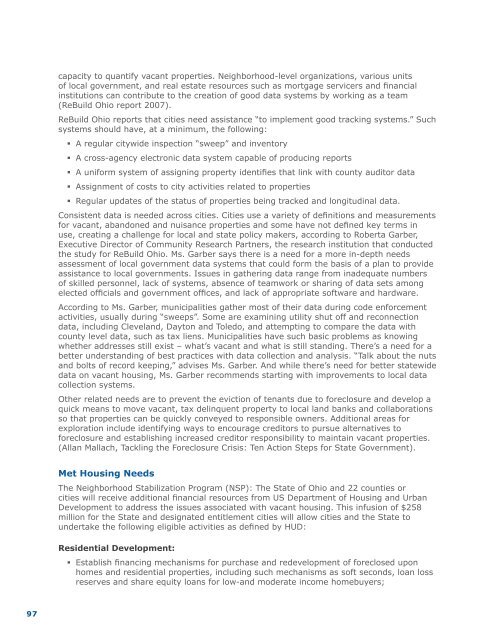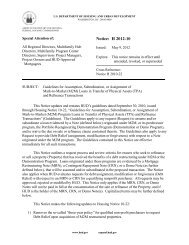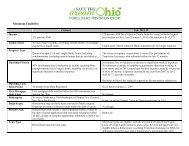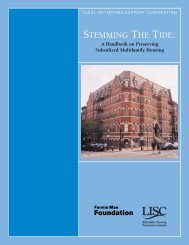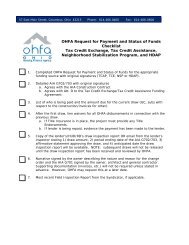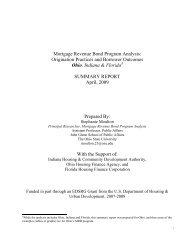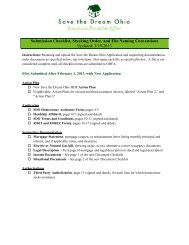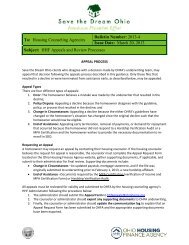Workgroup #7:Vacant <strong>Housing</strong>Workgroup members: Don Lenz (Greater Cincinnati Redevelopment Partnership, Inc.), JoelOwens (Community Building Partnership of Stark County), Amy Riegel (City of Dayton),Frank Ford (Neighborhood Progress, Inc.), Doug Harsany (OHCP), Marvin Hayes (Governor’sOffice), Dana Kozak (US Bank), Sharon Francis (MiraCit Development Corp.), Patricia Barnes(<strong>Ohio</strong> CDC Association), Karen Banyai and Matt Wootton (<strong>OHFA</strong>).Meeting history: 8/1, 8/13, 9/4, 9/22, 10/2, 10/9, 10/30<strong>Housing</strong> Need Description and its Urgency to <strong>Ohio</strong>A 2007 study of vacant properties in eight <strong>Ohio</strong> cities by ReBuild <strong>Ohio</strong> and CommunityResearch Partners identified more than 15,000 vacant and abandoned buildings. Most ofthese properties were residential since few cities have systems for tracking numbers ofvacant commercial and industrial properties. The study defined a “vacant property” as “…achronically vacant and uninhabitable property for which the owner is taking no active stepsto return the property to the market.” (p. iii, $60 Million and Counting: The cost of vacantand abandoned properties to eight <strong>Ohio</strong> cities).Data from the US Post Office (http://www.huduser.org/DATASETS/usps.html) shows astatewide total of 212,419 vacant residential properties in <strong>Ohio</strong> as of September 30, 2008using a definition of houses where mail has not been collected for three months.The ReBuild <strong>Ohio</strong> study points to a number of factors for the vacant property crisis, includingjob and population losses, an older housing stock, foreclosures and subprime lending, andproperty tax delinquencies in <strong>Ohio</strong>. Foreclosures in particular are widely seen as a majordriver of the large numbers of vacant homes in <strong>Ohio</strong>. Allan Mallach, in a report titled,Tackling the Mortgage Crisis: 10 Action Steps for State Government, reports that by the endof 2007, nearly one of eight mortgages of all types in Indiana, Michigan and <strong>Ohio</strong> was eitherin foreclosure or past due and one in 28 mortgages and nearly one in every five subprimeARM mortgages in those states was already in foreclosure. This crisis has disproportionatelyaffected predominantly minority neighborhoods where the majority of mortgage loans weresubprime loans (Allan Mallach, Tackling the Mortgage Crisis).The cost of vacant homes to <strong>Ohio</strong>’s cities is a major burden. In 2007, ReBuild <strong>Ohio</strong> reported$64 million in costs to eight local governments from demolition and boarding, grass cuttingand trash pickup, fire and police runs, tax losses, and additional code enforcement.The impact on neighborhoods, particularly in weak market cities, is devastating. Accordingto Allan Mallach, “where foreclosures lead to abandonment, neighborhoods can quicklydestabilize. The large volume of homes cannot be absorbed and are more often abandonedor purchased by a speculator as opposed to a homebuyer.” Properties are left with whatKermit Lind, a professor at Cleveland State University, calls “toxic titles” or titles that takea great deal of time and legal expertise to clear. Mallach asserts that abandoned propertiesare crime and fire hazards and cites a study in Philadelphia which found that a singleabandoned house on a block can reduce property values by 15 percent. The ReBuild <strong>Ohio</strong>study also found that in some neighborhoods where property flipping and negative realestate practices are prevalent, the reverse can be true. Properties close to abandonedhomes may actually be higher in value, as properties are turned over frequently byspeculators for more than their fair market value.Local governments, both large and small, are struggling to track vacant properties. Some,like Cleveland’s NEOCANDO project at Case Western, have model systems capable oftracking and even preventing foreclosures and vacancies, while others do not have the96
capacity to quantify vacant properties. Neighborhood-level organizations, various unitsof local government, and real estate resources such as mortgage servicers and financialinstitutions can contribute to the creation of good data systems by working as a team(ReBuild <strong>Ohio</strong> report 2007).ReBuild <strong>Ohio</strong> reports that cities need assistance “to implement good tracking systems.” Suchsystems should have, at a minimum, the following:• A regular citywide inspection “sweep” and inventory• A cross-agency electronic data system capable of producing reports• A uniform system of assigning property identifies that link with county auditor data• Assignment of costs to city activities related to properties• Regular updates of the status of properties being tracked and longitudinal data.Consistent data is needed across cities. Cities use a variety of definitions and measurementsfor vacant, abandoned and nuisance properties and some have not defined key terms inuse, creating a challenge for local and state policy makers, according to Roberta Garber,Executive Director of Community Research Partners, the research institution that conductedthe study for ReBuild <strong>Ohio</strong>. Ms. Garber says there is a need for a more in-depth needsassessment of local government data systems that could form the basis of a plan to provideassistance to local governments. Issues in gathering data range from inadequate numbersof skilled personnel, lack of systems, absence of teamwork or sharing of data sets amongelected officials and government offices, and lack of appropriate software and hardware.According to Ms. Garber, municipalities gather most of their data during code enforcementactivities, usually during “sweeps”. Some are examining utility shut off and reconnectiondata, including Cleveland, Dayton and Toledo, and attempting to compare the data withcounty level data, such as tax liens. Municipalities have such basic problems as knowingwhether addresses still exist – what’s vacant and what is still standing. There’s a need for abetter understanding of best practices with data collection and analysis. “Talk about the nutsand bolts of record keeping,” advises Ms. Garber. And while there’s need for better statewidedata on vacant housing, Ms. Garber recommends starting with improvements to local datacollection systems.Other related needs are to prevent the eviction of tenants due to foreclosure and develop aquick means to move vacant, tax delinquent property to local land banks and collaborationsso that properties can be quickly conveyed to responsible owners. Additional areas forexploration include identifying ways to encourage creditors to pursue alternatives toforeclosure and establishing increased creditor responsibility to maintain vacant properties.(Allan Mallach, Tackling the Foreclosure Crisis: Ten Action Steps for State Government).Met <strong>Housing</strong> NeedsThe Neighborhood Stabilization Program (NSP): The State of <strong>Ohio</strong> and 22 counties orcities will receive additional financial resources from US Department of <strong>Housing</strong> and UrbanDevelopment to address the issues associated with vacant housing. This infusion of $258million for the State and designated entitlement cities will allow cities and the State toundertake the following eligible activities as defined by HUD:Residential Development:• Establish financing mechanisms for purchase and redevelopment of foreclosed uponhomes and residential properties, including such mechanisms as soft seconds, loan lossreserves and share equity loans for low-and moderate income homebuyers;97
- Page 3 and 4:
OHFA Annual PlanThe Ohio Housing Fi
- Page 5:
Mission StatementsThe OHFA Annual P
- Page 8 and 9:
The State’s Housing NeedsAffordab
- Page 10 and 11:
Subject Matter Expert (SME) Workgro
- Page 12 and 13:
3. Financial LiteracyOHFA and other
- Page 14 and 15:
Affordable Housing Preservation & D
- Page 16 and 17:
federal subsidies. To achieve this
- Page 18 and 19:
Accessible HousingBackground DataOh
- Page 20 and 21:
3) Create dedicated funding streams
- Page 22 and 23:
• Recommend that Ohio support the
- Page 24 and 25:
Rural and Appalachian RegionsBackgr
- Page 26 and 27:
6. Annual Set-Asides and Incentives
- Page 28 and 29:
• Several cities in Ohio current
- Page 30 and 31:
OHFA should provide funding, traini
- Page 32 and 33:
Permanent Supportive Housing Produc
- Page 34 and 35:
3. The State should assist local Co
- Page 45 and 46: PrioritizationThe challenge of prio
- Page 47 and 48: Agency RecommendationsThe Annual Pl
- Page 49 and 50: APPENDIXWorkgroup 1: Affordable Hom
- Page 51 and 52: Executive SummaryHousing Need Descr
- Page 53 and 54: efficiency and resource conservatio
- Page 55 and 56: 554. Home Buyer Education in OHFA F
- Page 57 and 58: Estimated Units in Need of Some For
- Page 59 and 60: Ohio County Foreclosure Filings (19
- Page 61 and 62: Operating Costs - Met and Unmet Nee
- Page 63 and 64: Workgroup #2:Affordable Housing Pre
- Page 65 and 66: Secondary Recommendations• Explor
- Page 67 and 68: Executive SummaryOhio’s supply of
- Page 69 and 70: Met Housing Needs (“Resource Inve
- Page 71 and 72: Ohio Deptof MentalRetardation andDe
- Page 73 and 74: Unmet Housing NeedsData OverviewThe
- Page 75 and 76: ody, and will be built within the C
- Page 77 and 78: • OHFA will continue to maintain
- Page 79 and 80: Best Practices, Policies and Progra
- Page 81 and 82: addition, 60,111 one-person househo
- Page 83 and 84: Across Ohio, people with very low i
- Page 85 and 86: • Responsible for Rent - The pers
- Page 87 and 88: Seattle, St. Louis, and Washington,
- Page 89 and 90: Primary Recommendations• Create a
- Page 91 and 92: Unmet Housing Needs:• Due to the
- Page 93 and 94: • The cost of construction often
- Page 95: Recommendations for Annual Plan Adv
- Page 99 and 100: distributed on or about January 15,
- Page 101 and 102: Action is needed at the State level
- Page 103 and 104: a “user-friendly” data system,
- Page 105 and 106: 5) Incentivize the formation of bro
- Page 107 and 108: Workgroup #8:Permanent Supportive H
- Page 109 and 110: 3. Assist local Continuums of Care
- Page 111 and 112: Program and Resource InventoryNonpr
- Page 113 and 114: Table 2PopulationsPersons whoexperi
- Page 115 and 116: Examples: A national model for succ
- Page 117 and 118: oles, so they create a contract bet
- Page 119 and 120: Workgroup #8:Appendix ANameProgramD
- Page 121 and 122: or remedyingneglect, abuse,or the e
- Page 123 and 124: ased healthcare, and earlyintervent
- Page 125 and 126: “Bob” of Stark County, OhioPubl


